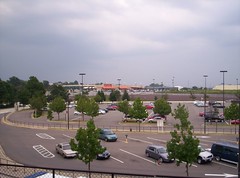The tyranny of neighborhood primacy
 Skyland Shopping Center photo from the Washington Post.
Skyland Shopping Center photo from the Washington Post.Earlier in the week I had an "argument-conversation" with a married couple that are prominent neighborhood activists in a part of the city that has been advocating for eminent domain to take over a shopping center and rebuild it with a Target, etc. [Skyland -- see previous blog entries "City Business as usual--land giveaways, diminishing urban design" and "Even more on eminent domain -- DC style"]
They want $40 million+ of government money spent on this project, but they don't want an urban design, mixed use, or adding residents, because "we already have density around that site." [An urban design type would probably disagree, and in some respects the issue is really "income density" as well as population density
I said to them "do you understand how many customers you need for thriving retail?" that when DC neighborhood commercial districts thrived there was little suburban competition and the average household had 3x+ the number of residents compared to today?
I was really surprised that they didn't feel that by giving the developer $40 million the city and the neighborhood didn't deserve much in return other than retail. I used the Brentwood example of a real wasted opportunity to improve an area beyond adding some retail. I suggested adding community facilities such as libraries to the center. They said "we don't want libraries [or other community uses] there.
I said something to the nature that this is opposite of all the Jacobian principles of what makes cities work. They countered that the rest of the city should respect their choices because of how long they've gone without.
I argued pretty vehemently that when you ask for green love (money) from the city's trough, as a citizen of the District of Columbia, not just a neighborhood, I have a right and a duty to advocate for sound choices with regard to the spending of this money, urban design, commercial and neighborhood revitalization, mixed use, etc. -- even if it's not my neighborhood.
Of course, this isn't just an issue in Ward 7. This kind of "you don't live here" mau-mauing goes on all the time, all across the city. I wish people could think more broadly than that. Maybe not to the extent of "Don't think what the city can do for you, but what you can do for the city" a la John F. Kennedy, but as a people we are capable of greatness even though we are so often so quick to settle for something marginally better than a parking lot.
 Brentwood Shopping Center overview, taken from the Rhode Island Metro subway platform.
Brentwood Shopping Center overview, taken from the Rhode Island Metro subway platform.Ironically, the trend in shopping center development is "asset intensification," bringing a variety of mixed-use projects to shopping centers, ranging from apartments and condominiums to hotels. Retail Traffic, a trade publication for retail, has an article "One-Stop Shopping," about this. For me, I look at Brentwood and think about how housing could have and should have been built there over the stores.



0 Comments:
Post a Comment
<< Home